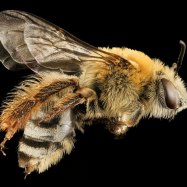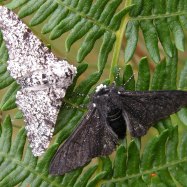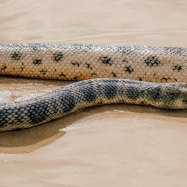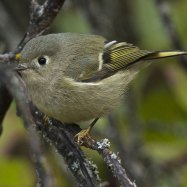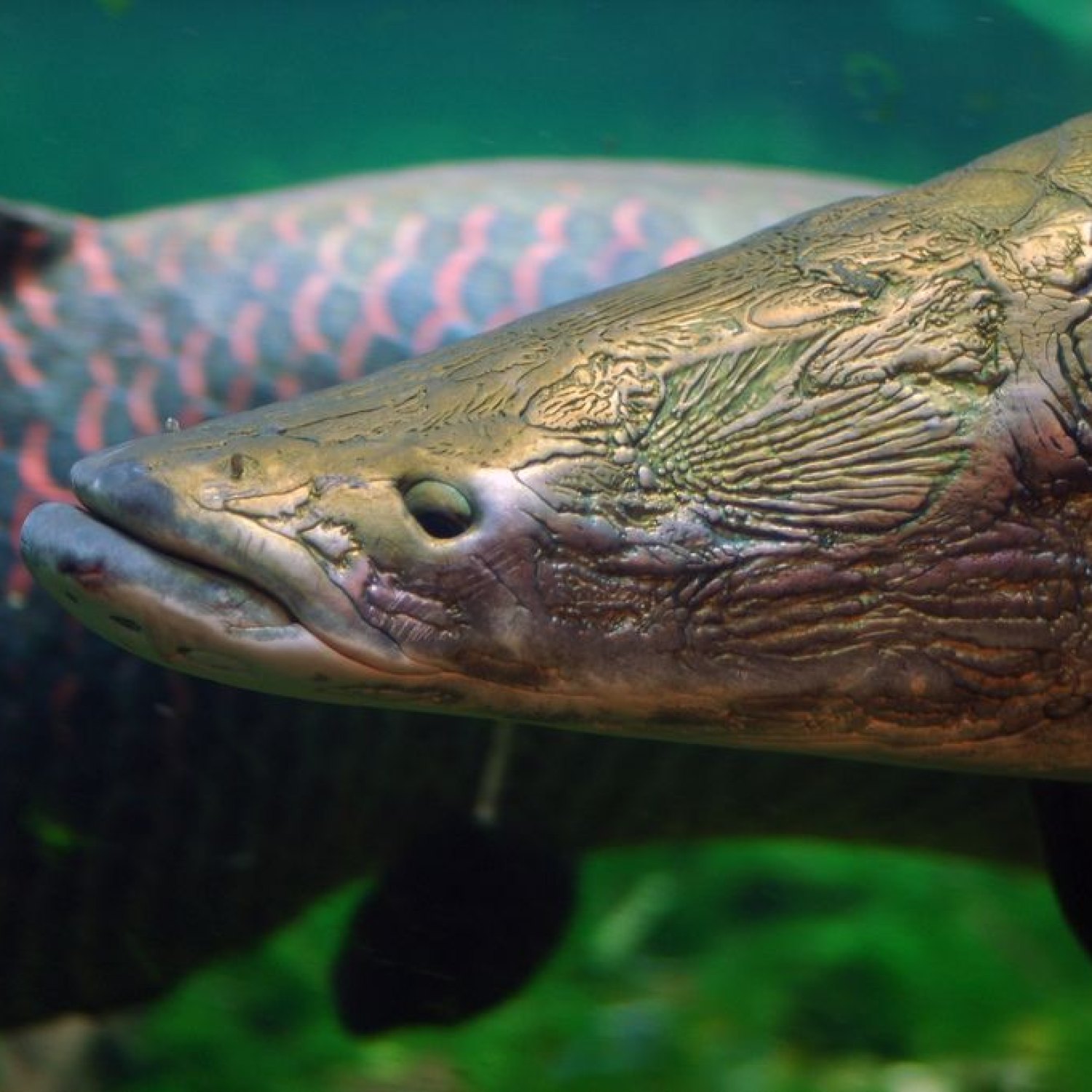
Arapaima
Up to 10 feet
Did you know that the Arapaima, also known as the giant freshwater fish, can reach up to 10 feet in length? These fish, found in the Amazon River Basin, belong to the Arapaimidae family and have an elongated and cylindrical body shape. They are one of the largest freshwater fish in the world and are an important source of food for the local communities. Stay tuned for more interesting animal facts! #Arapaima #AmazonRiver #FreshwaterFish
Animal Details Summary:
Common Name: Arapaima
Kingdom: Animalia
Habitat: Freshwater
Arapaima: The Mighty Giant of South America's Freshwaters
Imagine diving into the depths of the Amazon River Basin and encountering a creature that can grow up to 10 feet long and weigh over 400 pounds. Its elongated and cylindrical body, covered in grayish-brown scales, cuts through the water with ease as it searches for its next meal. This is the arapaima, one of the largest freshwater fish in the world.Native to the rivers of South America, the arapaima, also known by its scientific name Arapaima gigas, is a fascinating and powerful creature that has captured the attention of people around the world Arapaima. In this article, we will delve into the world of this magnificent fish and uncover some of its remarkable features.
The Taxonomy of Arapaima
Before we dive deeper into the world of arapaima, let's take a look at its taxonomy to gain a better understanding of where it fits into the animal kingdom. Arapaima belongs to the kingdom Animalia, which includes all animals; the phylum Chordata, which consists of animals with a notochord (a primitive backbone) during some stage of their development; and the class Actinopterygii, which includes ray-finned fish such as bony fish, sturgeons, and paddlefish.Next, we have the order Osteoglossiformes, which translates to "bony tongues," a group of freshwater fish that includes arapaima and other species like arowanas and pirarucu. Arapaima is the only extant species in the family Arapaimidae, making it a pretty unique creature. Its closest living relatives are thought to be the arowanas, which also reside in the Amazon River Basin.
Arapaima's Habitat and Distribution
As mentioned earlier, arapaima is found in the rivers and lakes of South America, particularly in the Amazon River Basin. This region covers over 7 million square kilometers, making it the largest drainage basin in the world. It spans across countries such as Brazil, Guyana, and Peru, which are the primary locations where arapaima can be found African Fish Eagle.These fish typically inhabit calm, deep waters with abundant plant life, such as the flooded forests of the Amazon. They are also known to reside in oxbow lakes, which are old, curved sections of a river that have been cut off from the main channel. These lakes provide the perfect hiding spot and food source for the arapaima.
A Carnivorous Appetite
Arapaima is a carnivorous fish, meaning they primarily feed on other animals. It is not uncommon for these creatures to consume about 200 pounds of food in a single year, which is about 70% of their body weight. Their diet mainly consists of fish, including other species of bony tongues, piranhas, and catfish. They are known to be opportunistic feeders, which means they will eat whatever prey is available at the time. This includes small mammals, turtles, and even birds.Arapaima's unique hunting strategy lies in their ability to gulp air from the surface of the water and store it in their air bladder. This helps them survive in oxygen-poor waters. But it also allows them to rise to the surface to ambush their prey. Their powerful tails propel them through the water with great force, giving them an advantage over their prey.
The Mighty Size of Arapaima
One of the most impressive features of the arapaima is its size. On average, these fish grow to be around 6 to 9 feet long and weigh between 200 to 400 pounds. However, some individuals have been recorded to reach up to 10 feet in length and weigh over 440 pounds.Apart from their incredible length and weight, arapaima also has a remarkable lifespan. It is not uncommon for these fish to live for over 15 years in the wild, with some reaching up to 20 years of age. This makes them one of the longest-lived freshwater fish species.
Arapaima's Unique Coloration and Body Shape
The distinctive appearance of the arapaima is another reason why these fish have captured the fascination of many people. Their elongated and cylindrical body, along with their grayish-brown scales, gives them a sleek and powerful appearance. These scales cover their entire body, except for their fins and head, which have a reddish tint.But what is even more interesting is that arapaima can change color based on their surroundings. When in murky waters, they appear darker to blend in with the environment, making it easier for them to hunt and hide from predators.
Conservation and Threats to Arapaima
Like many other species living in the Amazon River Basin, arapaima is facing numerous threats to their survival. The primary threat comes from overfishing, both for the consumption of their flesh and their precious air bladder, which is sold for traditional medicine in some cultures. This has led to a significant decline in their populations, and they are now listed as vulnerable on the IUCN Red List.Fortunately, many organizations, including the Amazon River Conservancy, are working towards protecting arapaima and their habitats. Along with implementing regulations on fishing, there are also efforts to establish sustainable farming methods for these fish, which can provide an alternative to wild-caught arapaima. These efforts will not only help protect the species but also support the local communities that rely on these fish for their livelihoods.
The Inspiration behind Arapaima's Name
Finally, it's worth mentioning the inspiration behind the name "arapaima." It is believed to originate from the indigenous words "arapinga" and "paima" used in different regions of South America, which translate to "arigabela" and "manca," meaning "stabbing fish" and "crocodile killer," respectively. These names were given due to the powerful hunting strategies and massive size of these fish, which were often compared to the strength of a crocodile.Final Thoughts
The arapaima is a remarkable creature that has captured the attention of people around the world. From its unique hunting strategies and impressive size to its adaptability and conservation efforts, there is much to learn and admire about this fish. And as ongoing efforts continue to protect and conserve these magnificent creatures, we can hope to see them thrive in their natural habitats for generations to come.

Arapaima
Animal Details Arapaima - Scientific Name: Arapaima gigas
- Category: Animals A
- Scientific Name: Arapaima gigas
- Common Name: Arapaima
- Kingdom: Animalia
- Phylum: Chordata
- Class: Actinopterygii
- Order: Osteoglossiformes
- Family: Arapaimidae
- Habitat: Freshwater
- Feeding Method: Carnivorous
- Geographical Distribution: South America
- Country of Origin: Brazil, Guyana, Peru
- Location: Amazon River Basin
- Animal Coloration: Grayish-brown
- Body Shape: Elongated and cylindrical
- Length: Up to 10 feet
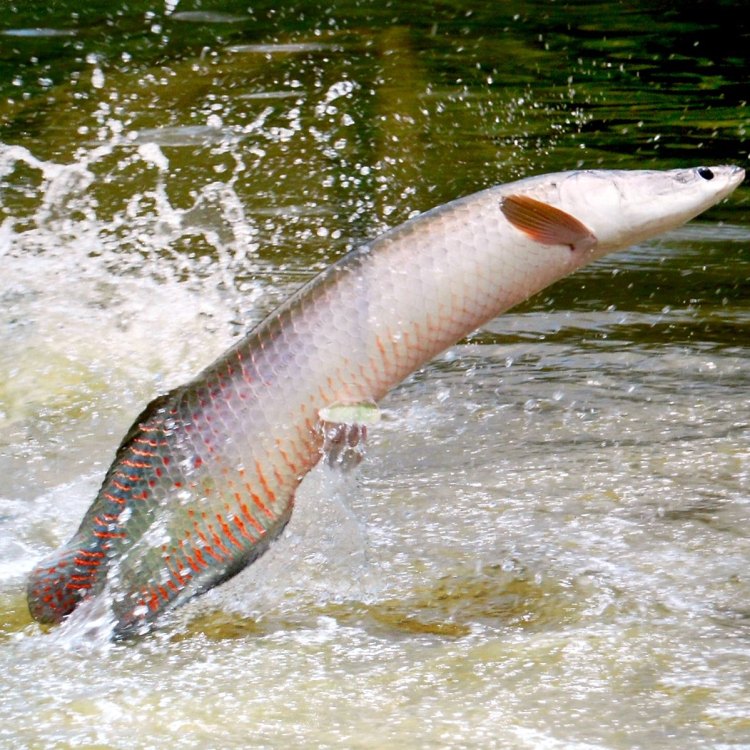
Arapaima
- Adult Size: 6-10 feet
- Average Lifespan: Up to 20 years
- Reproduction: Oviparous
- Reproductive Behavior: Male guards the nest
- Sound or Call: Low frequencies during courtship
- Migration Pattern: Migrates to flooded forests during the rainy season
- Social Groups: Solitary or small groups
- Behavior: Predatory and territorial
- Threats: Overfishing and habitat loss
- Conservation Status: Vulnerable
- Impact on Ecosystem: Keystone predator
- Human Use: Fishing and aquaculture
- Distinctive Features: Large size and bony tongue
- Interesting Facts: One of the largest freshwater fish in the world
- Predator: Humans, caimans, jaguars
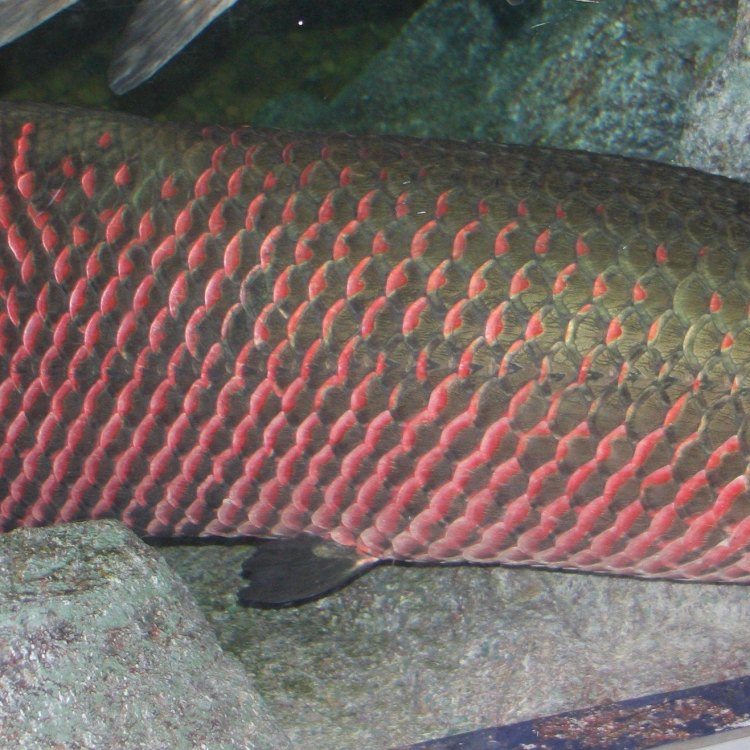
Arapaima gigas
The Mighty Arapaima: A Fascinating Giant of the Amazon
In the rivers of the Amazon rainforest, there swims a creature that has captured the imagination of scientists and nature lovers alike. This massive fish, known as the arapaima, is a true giant of the freshwater world. With a length of 6-10 feet and a weight of up to 440 pounds, the arapaima stands out as one of the largest freshwater fish in the world. But its size is not the only thing that makes this species unique PeaceOfAnimals.Com. From its behavior to its impact on the ecosystem, there is much to discover about the mighty arapaima.Let's dive deeper into the world of this extraordinary fish and unravel its fascinating characteristics and behaviors.
The Basics: Size, Lifespan, and Reproduction
One of the first things that stands out about the arapaima is its sheer size. As mentioned earlier, an adult arapaima can reach up to 6-10 feet in length, making it one of the largest freshwater fish in the world. In terms of weight, it can weigh up to 440 pounds, which is equivalent to the weight of three average-sized adults!But despite its massive size, the arapaima has a relatively short lifespan of around 20 years. This may be due to its vulnerability to various threats, such as overfishing and habitat loss, which we will explore in detail later on.
When it comes to reproduction, the arapaima is oviparous, meaning it lays eggs. Male arapaimas are responsible for guarding the eggs until they hatch, which takes about 5-10 days. This behavior is seen in many other fish species as well, but the male arapaima takes this task very seriously and will not leave the nest until the eggs hatch Amazon River Dolphin.
A Chorus of Low Frequencies: Courtship Calls of the Arapaima
In the animal kingdom, communication is key. And the arapaima has its unique way of communicating with its own kind. During the breeding season, which typically occurs during the rainy season, male arapaimas produce low-frequency sounds to attract females. This type of communication is known as courtship calls, and these low-frequency sounds can travel far in the water, allowing females to locate the males.Interestingly, these calls can also serve as a warning to other males, who may see the male's presence as a territorial threat. This behavior, commonly seen in other fish species, is crucial for maintaining a stable social structure within a species.
From the River to the Forest: Migration Patterns of the Arapaima
Migrating for food or breeding is a common behavior seen in many species, and the arapaima is no different. During the rainy season, when water levels rise, arapaimas migrate to flooded forests in search of food and suitable breeding spots. These forests, known as várzeas, are full of vegetation and provide an abundance of food, making it an ideal spot for the arapaima.This unique migration pattern allows the arapaima to survive in a constantly changing environment and highlights its adaptability as a species.
Solitary or Social: Understanding the Behavior of the Arapaima
Just like humans, the arapaima can be found living in both solitary and social groups. When they are not migrating, they are usually solitary creatures, spending most of their time patrolling their territory, which can reach up to 150 feet in diameter.However, during the breeding season, male arapaimas come together to compete for females' attention, forming small temporary social groups. This behavior is crucial for maintaining genetic diversity within the population and ensuring the species' survival.
The Predator of the Amazon: Hunting and Territorial Behavior
With its large size, the arapaima may seem like the most dominating predator in the Amazon. And that is a fair assumption. These fish are known for their predatory behavior and have been observed preying on other fish, turtles, birds, and even small mammals.But they are also very territorial creatures and will fiercely defend their territory from other fish species. This territorial behavior is crucial for their survival, as it ensures they have a steady supply of prey in their territory.
A Vulnerable Species: Understanding the Threats to the Arapaima
Despite their strength and adaptability, the arapaima is listed as Vulnerable on the International Union for Conservation of Nature (IUCN) Red List of Threatened Species. Their main threats are overfishing and habitat loss, caused by human activities such as hydroelectric dams and deforestation.The arapaima is a highly prized food fish, and its large size makes it an easy target for fishermen. In many areas, the arapaima population has declined drastically due to overfishing, and this has also disrupted the balance of the ecosystems they inhabit.
An Ecosystem Engineer: The Arapaima as a Keystone Predator
The arapaima's crucial role in the ecosystem is not just limited to being a top predator. These fish are considered to be "keystone predators," meaning they have a disproportionately large impact on their ecosystems. As they prey on smaller fish and control their population, they indirectly affect plant growth, water quality, and the entire food chain.When the arapaima population declines, it can have a ripple effect on the entire ecosystem, causing imbalances and potential collapse. This is why conservation efforts are crucial in ensuring the survival of this majestic species.
The Human Connection: Fishing and Aquaculture
Human use of the arapaima dates back centuries, with indigenous communities in the Amazon using the fish for food and cultural traditions. Today, the arapaima is still an important source of protein for many communities in the Amazon and is also commercially farmed for food.Aquaculture, the farming of fish for commercial purposes, has become a popular method for sustainable harvesting of arapaimas. This reduces the pressure on wild populations and allows communities to continue benefiting from the fish without endangering the species' survival.
A Fish with Unique Features: The Bony Tongue
Aside from its large size, the arapaima is also known for its distinctive features. One of its most unique features is its bony tongue. This massive tongue, covered in tiny teeth, helps the arapaima grip and crush its prey, making it an efficient predator.Another interesting feature is its ability to breathe air. The arapaima has a primitive lung called a "swim bladder," which it uses to take in oxygen. This allows them to survive in low-oxygen environments and even travel short distances on land.
Final Thoughts: A Fascinating Giant of the Amazon
The arapaima is truly a remarkable and fascinating species. From its massive size and unique features to its complex behaviors and vital role in the Amazon ecosystem, there is much to learn and appreciate about this fish.But with the increasing threats facing this species, it has become more important than ever to raise awareness and take action to protect the arapaima. With proper conservation efforts and sustainable practices, we can ensure that this majestic giant of the Amazon continues to thrive for generations to come. So, let us all appreciate and protect the mighty arapaima, a true giant of the Amazon.
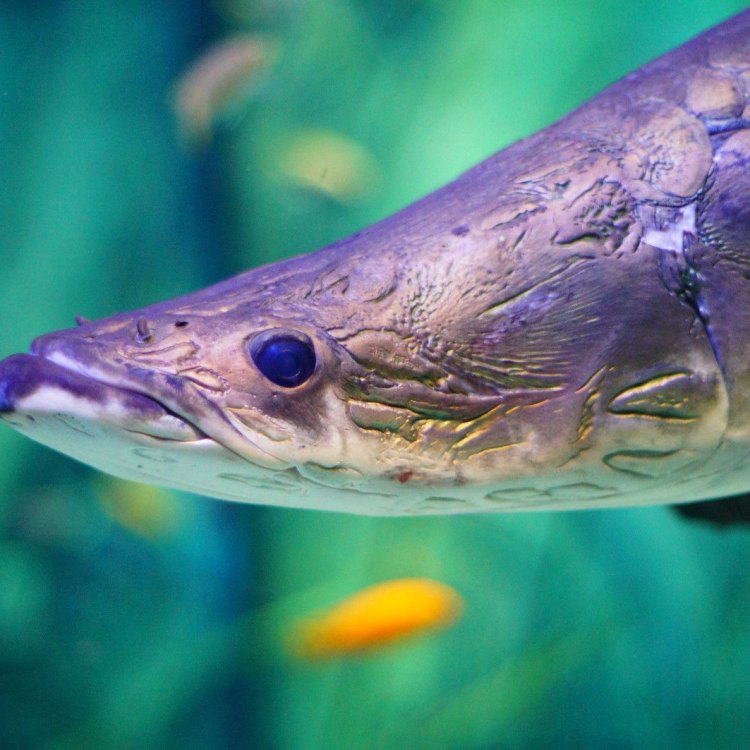
Arapaima: The Mighty Giant of South America's Freshwaters
Disclaimer: The content provided is for informational purposes only. We cannot guarantee the accuracy of the information on this page 100%. All information provided here may change without prior notice.


